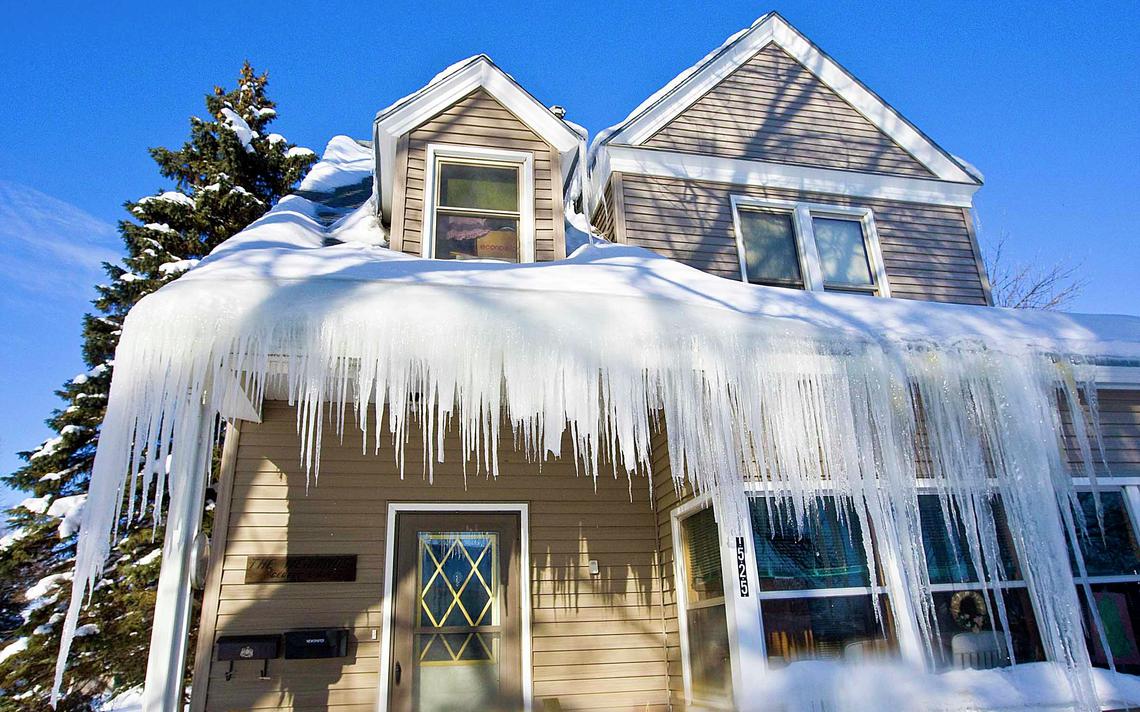
Dear Eartha, I have massive icicles building up on my roof. How do I avoid these in the future, and what other winter maintenance concerns should be addressed?
“Ice dam” is the technical term for giant stalactites of frozen water cascading off your roof. And while all that ice might have you thinking about adding pretty lights and charging an entrance fee for your own ice castle display, ice dams are a major concern.
Ice dams can lead to premature roof failures, leaks in our homes, and threaten to impale us as we risk it all just to enter our own homes. Ultimately, the ice dam is merely a symptom of a deeper issue prevalent across much of the county.
Many contractors turn to de-icing cable, often referred to as heat tape, which applies heat directly to the affected areas of our roofs. Installing several hundred feet of de-icing cable on the lower sections of your roof, these contractors seem to have saved the day … until you see your utility bill.

The harsh truth about de-icing cable is that it uses a lot of electricity – about 6 watts per linear foot at 32 degrees Fahrenheit, and even more at lower temperatures. If 100 linear feet of cable is utilized for 6 months of the year, it will consume more than 2,600 Kilowatt hours of electricity at a cost of $300. With the average Summit County home using around 9,800 kilowatt hours for an entire year, this one appliance could account for roughly 20% of your energy costs!
While we don’t recommend using de-icing cable, if you must use it for safety reasons, consider installing a timer to run the heat tape from 6am to 6pm and only when there is snow on the roof. It may seem counter-intuitive, but the best time to run heat tape is during the day when it’s sunny and the temperature is above 32 degrees Fahrenheit.
There are two actions that cause snow to melt on roofs. The primary action is caused when indoor heat is lost through the attic or vaulted ceiling space, heating your roof which in turn causes snow to melt. The melted snow trickles down your roof until it reaches the eave (the section of roof extending beyond your exterior walls). At the eaves, the melted water no longer absorbs the heat loss from the main part of your roof, so it re-freezes and – voila – you have the beginning of an ice dam.
As more ice accumulates, it traps water still flowing down the roof, trapping more water behind it. As these dams grow, icicles begin to form from excessive water flowing up over the dam. Ultimately, this water that remains trapped behind the dam may penetrate the roof and manifest as a leak within your home.
The secondary action that causes snow to melt on roofs is sunlight and warmer temperatures. This action however typically affects the entire roof area including the eave, and is less likely to create an ice dam, unless of course an ice dam is already present. The proper solution to the core cause of ice dams is to reduce indoor heat loss through your roof.

I recommend improving your attic or vaulted ceiling insulation and maximizing the roof’s ventilation. We are after a roof temperature that always matches the outdoor temperature. Therefore, the insulation in your attic sits against your ceiling to keep the heated air down, where it’s needed in the home. If you have cathedral or vaulted ceilings in your home, the solution remains the same. Ventilation baffles should be installed in your vaulted roofs, conducting outdoor airflow across the underside of your roof sheathing before it exits near the peak of your roof.
If you’re considering an energy efficiency improvement for your home, or even if you want to learn more about reducing the ice dams on your home, you should start with an energy audit. Have a certified building analyst inspect your home for both potential safety concerns and energy efficiency.
To request this service, visit HighCountryConservation.org. Assessments will be scheduled for later in the year when restrictions have lifted for non-essential businesses. The most important first step in solving problems at your home is education. Through a home energy audit, you’ll understand what your home truly needs.
